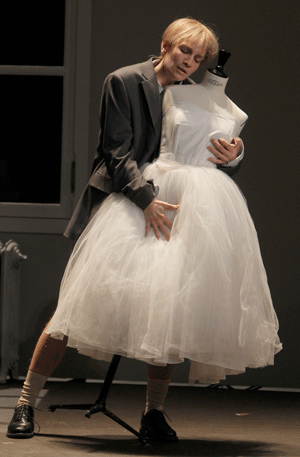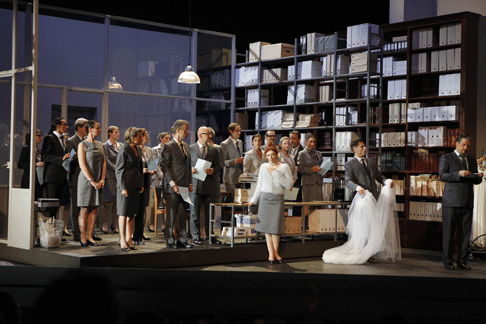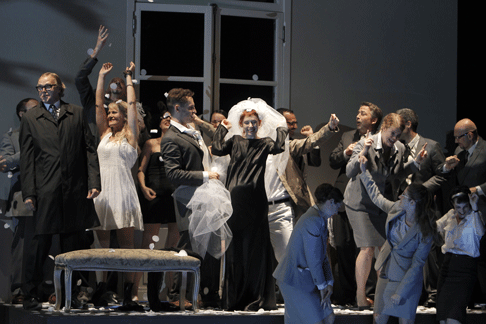![Patricia Petibon as Susanna, Malin Byström as the Countess and Kate Lindsey as Cherubino [Photo by Pascal Victor / Artcomart, courtesy of the Aix Festival]](http://www.operatoday.com/LE-NOZZE449-Acte-2%2C-Patrici.gif)
18 Jul 2012
Le Nozze di Figaro in Aix-en-Provence
You pay your money, you takes your chances — that is festival life at its best. Sometimes it pays off and sometimes it doesn’t. The fun is in the risk, so the riskier the better.
English Touring Opera are delighted to announce a season of lyric monodramas to tour nationally from October to December. The season features music for solo singer and piano by Argento, Britten, Tippett and Shostakovich with a bold and inventive approach to making opera during social distancing.
This tenth of ten Live from London concerts was in fact a recorded live performance from California. It was no less enjoyable for that, and it was also uplifting to learn that this wasn’t in fact the ‘last’ LfL event that we will be able to enjoy, courtesy of VOCES8 and their fellow vocal ensembles (more below …).
Ever since Wigmore Hall announced their superb series of autumn concerts, all streamed live and available free of charge, I’d been looking forward to this song recital by Ian Bostridge and Imogen Cooper.
The Sixteen continues its exploration of Henry Purcell’s Welcome Songs for Charles II. As with Robert King’s pioneering Purcell series begun over thirty years ago for Hyperion, Harry Christophers is recording two Welcome Songs per disc.
Although Stile Antico’s programme article for their Live from London recital introduced their selection from the many treasures of the English Renaissance in the context of the theological debates and upheavals of the Tudor and Elizabethan years, their performance was more evocative of private chamber music than of public liturgy.
In February this year, Albanian soprano Ermonela Jaho made a highly lauded debut recital at Wigmore Hall - a concert which both celebrated Opera Rara’s 50th anniversary and honoured the career of the Italian soprano Rosina Storchio (1872-1945), the star of verismo who created the title roles in Leoncavallo’s La bohème and Zazà, Mascagni’s Lodoletta and Puccini’s Madama Butterfly.
Evidently, face masks don’t stifle appreciative “Bravo!”s. And, reducing audience numbers doesn’t lower the volume of such acclamations. For, the audience at Wigmore Hall gave soprano Elizabeth Llewellyn and pianist Simon Lepper a greatly deserved warm reception and hearty response following this lunchtime recital of late-Romantic song.
Collapsology. Or, perhaps we should use the French word ‘Collapsologie’ because this is a transdisciplinary idea pretty much advocated by a series of French theorists - and apparently, mostly French theorists. It in essence focuses on the imminent collapse of modern society and all its layers - a series of escalating crises on a global scale: environmental, economic, geopolitical, governmental; the list is extensive.
For this week’s Live from London vocal recital we moved from the home of VOCES8, St Anne and St Agnes in the City of London, to Kings Place, where The Sixteen - who have been associate artists at the venue for some time - presented a programme of music and words bound together by the theme of ‘reflection’.
'Such is your divine Disposation that both you excellently understand, and royally entertaine the Exercise of Musicke.’
Amongst an avalanche of new Mahler recordings appearing at the moment (Das Lied von der Erde seems to be the most favoured, with three) this 1991 Mahler Second from the 2nd Kassel MahlerFest is one of the more interesting releases.
‘And there was war in heaven: Michael and his angels fought against the dragon; and the dragon fought and his angels, And prevailed not; neither was their place found any more in heaven … that old serpent … Satan, which deceiveth the whole world: he was cast out into the earth, and his angels were cast out with him.’
If there is one myth, it seems believed by some people today, that probably needs shattering it is that post-war recordings or performances of Wagner operas were always of exceptional quality. This 1949 Hamburg Tristan und Isolde is one of those recordings - though quite who is to blame for its many problems takes quite some unearthing.
There was never any doubt that the fifth of the twelve Met Stars Live in Concert broadcasts was going to be a palpably intense and vivid event, as well as a musically stunning and theatrically enervating experience.
‘Love’ was the theme for this Live from London performance by Apollo5. Given the complexity and diversity of that human emotion, and Apollo5’s reputation for versatility and diverse repertoire, ranging from Renaissance choral music to jazz, from contemporary classical works to popular song, it was no surprise that their programme spanned 500 years and several musical styles.
The Academy of St Martin in the Fields have titled their autumn series of eight concerts - which are taking place at 5pm and 7.30pm on two Saturdays each month at their home venue in Trafalgar Square, and being filmed for streaming the following Thursday - ‘re:connect’.
The London Symphony Orchestra opened their Autumn 2020 season with a homage to Oliver Knussen, who died at the age of 66 in July 2018. The programme traced a national musical lineage through the twentieth century, from Britten to Knussen, on to Mark-Anthony Turnage, and entwining the LSO and Rattle too.
With the Live from London digital vocal festival entering the second half of the series, the festival’s host, VOCES8, returned to their home at St Annes and St Agnes in the City of London to present a sequence of ‘Choral Dances’ - vocal music inspired by dance, embracing diverse genres from the Renaissance madrigal to swing jazz.
Just a few unison string wriggles from the opening of Mozart’s overture to Le nozze di Figaro are enough to make any opera-lover perch on the edge of their seat, in excited anticipation of the drama in music to come, so there could be no other curtain-raiser for this Gala Concert at the Royal Opera House, the latest instalment from ‘their House’ to ‘our houses’.
"Before the ending of the day, creator of all things, we pray that, with your accustomed mercy, you may watch over us."
![Patricia Petibon as Susanna, Malin Byström as the Countess and Kate Lindsey as Cherubino [Photo by Pascal Victor / Artcomart, courtesy of the Aix Festival]](http://www.operatoday.com/LE-NOZZE449-Acte-2%2C-Patrici.gif)
You pay your money, you takes your chances — that is festival life at its best. Sometimes it pays off and sometimes it doesn’t. The fun is in the risk, so the riskier the better.
Yes, it was risky indeed for the Festival’s umpteenth production of Le Nozze di Figaro by the Festival’s signature composer, W.A. Mozart (that’s Mose-art in French by the way). Richard Brunel, director of the Comédie de Valence (a small city south of Lyon), re-conceived Beaumarchais’ testy little comedy to take place in a contemporary notaire’s office, or maybe it was an avocat’s office or some sort of corporate office where Barbarina was the receptionist (it was confusing), with grand doors embedded into the stage left wall leading into, we later learned, a large room with two sewing machines.
 Kate Lindsey as Cherubino
Kate Lindsey as Cherubino
It seems that there was to be an office wedding with Susanna and Marcellina arguing who was going to wear the wedding veil (Via, resti servita), a long white filmy thing that was on stage most of the opera. The count, who was a lawyer or something, sometimes brought his dog to the office as if he had just been hunting and still had his gun with him. His dog was really smart and sniffed out the door behind which Cherubino was hiding and guarded it while the Count, strangely lacking janitorial staff, went to get some tools. Later when things got out-of-hand between the Count and Countess the dog barked in just the right place, the only moment he could get a bark in.
A court room appeared on stage right, abutting the count’s office. Everyone soon gathered for various reasons and then the Countess wandered in too and sang her Dove sono (translation: Where am I?). In the end the Countess wore a wedding gown to disguise herself as Susanna, and Susanna wore black with a high grey turban to hide the Countess’ long blond hair (we had been amazed earlier by this strange coiffure on the Countess ). The sterile (no plants) garden seemed to be behind some featureless house in a French banlieue (suburb) parts of which kept sliding eerily about the stage making everyone even sleepier (it was 1:30 AM by then).
 Patricia Petibon as Susanna, Kyle Ketelsen as Figaro and Paolo Szot as the Count
Patricia Petibon as Susanna, Kyle Ketelsen as Figaro and Paolo Szot as the Count
The curtain fell (well, a large flat thing slowly descended) and when it rose for the artists to take their bows the star of the show appeared alone on the stage. Yes! The dog.
Some very good singers then made their way onto the stage to accept applause. Figaro, American baritone Kyle Ketelson, of course had the final bow. Mr. Ketelsen had a huge success two years ago in Aix as Don Giovanni’s cheeky sidekick, a very physical Leporello. He is a vivid performer who projects text to perfection but dressed in a suit and tie his cheek did not find character in Figaro. The biggest ovation went to Cherubino, American mezzo Kate Lindsay, dressed in a suit and tie who fussed with the Countess’ bra (the libretto says ribbon) and sang breathlessly making Mozart’s young lover quite fun and real.
Brazilian baritone Paolo Szot who was to have appeared in Aix’s Nose but did not was the Count. Mr. Szot has a quite beautiful voice, beautifully used. He is often strangely type miscast in big houses (because he is South American i.e. latin) as Escamillo in spite of a soft, pretty presence. He did not read as a bonafide sexual predator, and made Almaviva seem even sympathetic and misunderstood in his garden escapade.
 John Graham-Hall as Basilio, Mari Eriksmoen as Barbarina, Kyle Ketelsen as Figaro and Patricia Petibon as Susanna
John Graham-Hall as Basilio, Mari Eriksmoen as Barbarina, Kyle Ketelsen as Figaro and Patricia Petibon as Susanna
These were the big house singers. Things got risky with French soprano Patricia Petibon as Susanna and Swedish soprano Malin Byström as the Countess. Mlle. Petibon gave Susanna a quite saucy “ina” (Zerlina, Despina) character in a quite smokey voice that precluded any text projection. At first it seemed Mlle. Byström might be a Swedish dramatic soprano in training, but it became apparent that she is a lovely, quite beautiful singer who does not project strong character. Both women boast important credits in early music so perhaps the attributes that made their performances pale on the Archevêché stage are valuable in other circumstances. The singers in the supporting character roles were swallowed up in the concept.
The evening’s conceit seems to have been to juxtapose hard edge contemporary dramaturgy and design with real, old, decorative music, a conceit that in some circumstances might spawn better results. The risky orchestra in Aix was Le Cercle de l’Harmonie, a group based in Deauville (Normandy) led by violinist/conductor Jérémie Rhorer, a protégé of William Christie. This orchestra has been specifically built to perform the music of the late 18th century (i.e. Mozart and Hadyn). As it was from row M in the Archevêché the music seemed long ago and far away, a bit like an old reed organ without sufficient air supply. Conductor Rhorer’s tempi seemed appropriate for the occasion.
Maybe you had to be French.
Michael Milenski